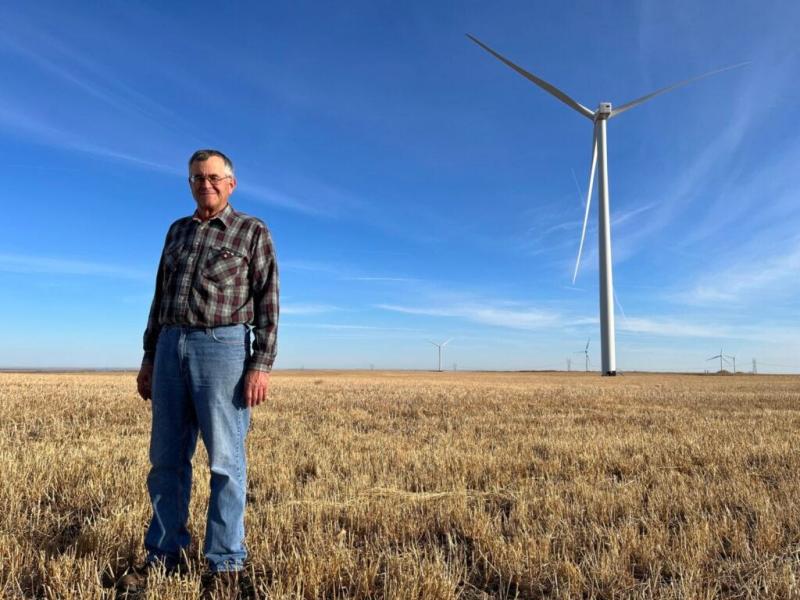Wind energy is now South Dakota's No. 1 producer of electricity, but not every day
By: Joshua Haiar (Argus Leader)


Not difficult to see where this is headed. It won't be long before urban politicians will be complaining about wind barons in rural areas. Those big city mayors will be demanding rate cuts and an end to subsidies. And urbanites will be up in arms over rural areas cheating cities.
It's not difficult for sparsely populated states to become leaders in alternative energy. There's lots of open land and the promise of added income is always appealing. That's not any different than pump jacks spread across the countryside throughout the Midwest. America's green energy future will be built in rural areas simply because it's easier, cheaper, and less disruptive. So, these less populous states will be generating more electricity than they'll use. As with fossil fuels, the money will flow out of urban centers. And urban politicians aren't going to be cheated out of a piece of pie that isn't theirs to begin with.

Wind has surpassed hydroelectric power as the largest generator of electricity in South Dakota.
Last year, over 52% of the electricity generated in the state came from wind turbines.
That's because of a large number of new, better turbines built in recent years. The state was home to 526 turbines before 2019. Another 511 were constructed from 2019 to 2021.
South Dakota now produces twice as much electricity as it uses. It exports the rest to nearby states, according to the Public Utilities Commission. Commissioner Kristie Fiegen said newer wind projects were motivated by more transmission lines, available tax credits that developers feared were coming to an end, and technological advancements that make turbines a more feasible investment.
But producing the majority of electricity in a year doesn't mean wind produces the majority every day. That day-to-day number can vary greatly, Fiegen said.
Because of that and the lack of a way to store energy produced during previous periods, it is important to have reliable backup sources, according to Fiegen.
"We have to have that coal and natural gas to support the wind when it's not blowing or the solar when the sun's not shining," she said.
Fiegen said things like coal, natural gas and nuclear are the energy backups South Dakota may need until large batteries are capable of storing the unused electricity currently being exported.
South Dakota Renewable Energy Association Analyst Steve Wegman agrees. But he is optimistic that efficient air conditioning and heating systems, alternative energy storage projects, and recent federal investments will dramatically reduce the reliance on non-renewables soon.
For example, there is renewed interest in the Gregory County Pumped Storage Project. That project would use electricity generated when demand is low to pump water uphill into a proposed reservoir. Gravity would then bring the water down into an existing, lower reservoir on the Missouri River, turning a turbine to generate power when demand is higher.
Plus, the Inflation Reduction Act passed by Congress and signed by President Biden includes investments for additional turbines and more transmission lines. The bill also includes tax credits for large in-home batteries - often called a "power wall."
As wind continues
Nearly all of South Dakota's major wind energy projects are East River.
Steve Wegman said that's for a number of reasons.
"For one, the demand for electricity in West River South Dakota is about the same as the greater Sioux Falls metro area alone. Additionally, the underlying infrastructure, like transmission lines, already exists in eastern South Dakota," he said.
Wegman said there have been few new transmission lines built in western South Dakota in recent decades.
New wind energy development in South Dakota is likely to plateau until more of that underlying infrastructure is constructed, according to Wegman.
"All of our big transmission lines are full and until we get more built, there is no use in building more turbines," Wegman said.
Love it or hate it
In some areas of the state, wind energy is a tax-revenue generator for local governments.
Wessington Springs School District received over $150,000 in tax revenue in 2022 from the two major wind energy projects in Jerauld County, according to County Auditor Shannon Fagerhaug. The county itself received another $110,000 that's primarily used to maintain and develop roads, and another $47,000 was split among four townships in the county, Fagerhaug said.
Regardless, stories about turbines being loud and killing birds are common. Wind-energy analyst Steve Wegman said those stories are overblown, citing an article saying, "wind farms killed approximately 7,000 birds in the United States in 2006 but nuclear plants killed about 327,000 and fossil-fueled power plants 14.5 million."
"On a windy day, you'll hear the corn rustling and trucks traveling a lot more than these turbines. What people are really upset about is the wind developers not choosing their land to build on," Wegman said.
Wind turbines are sited far enough from homes that noise is minimal, according to the U.S. Department of Energy. The department says a nearby wind plant is no louder than a refrigerator heard from another room.
A wind turbine went up on Nick Nemec's 5,000-acre farm near Highmore one year ago. He said the turbine is no louder than a combine and the noise is hardly audible from the nearest public road.
"It's a very vocal minority that complains about them. There are too many people listening to far-right fossil fuel types that don't like them because it's eating into their business," Nemec said.
Nemec gets paid yearly based on the amount of electricity the turbine produces. He received about $14,000 for the first year and donated the entire check to help build a new local swimming pool.
Wind energy is here to stay, regardless of how anyone feels about it, according to Steve Wegman.
"It's still in its infancy and we're still growing with it. And we will keep growing with wind energy for a long time," Wegman said. "For example, hydroelectric power in the early 1900s was hardly capable of producing the amount of electricity it does today. We're still in that early phase with wind."
Because of that, Noah Brinkman, a wind turbine technology instructor at Mitchell Tech, is confident the workforce needs of the wind energy sector will continue for the foreseeable future. He points to numbers from the technical college showing it has graduated 170 wind turbine technicians with a 100% job placement rate.
"There's always going to be blade work, greasing, torquing to be done, gearboxes will go bad," Brinkman said. "It's like the automotive industry. You're always going to need your oil changed, your brakes changed, things will need to be fixed."

Tags
Who is online
100 visitors


Urban generators operating on natural gas won't be replaced with wind turbines and solar panels. There isn't any room and urbanites will complain about the skyline. Not difficult to see that urban politicians are going to begin complaining about being cheated because the money is flowing out of the cities and making rural wind barons rich.
I don't see that happening at all. It's no different from rural oil barons getting rich except that it's much much cleaner. I can see urban politicians touting the clean renewable energy sources that they "helped to create". Whether they helped to create them or not.
Urban centers are going to lose quick mart gas stations. Those gas stations are going to need to change their business model and will likely begin competing with fast food. And the advent of home charging will likely become more popular to avoid taxes and fees.
The transition to EVs will be far more disruptive than we're being told. The gas pumps aren't just going to be replaced with charging stations. Urban politicians are going to need a replacement revenue stream (i.e. taxes) and they'll adopt the easy narrative of scapegoating rural wind barons.
Nobody said it was going to be easy. I agree that we'll need a replacement revenue stream. This has been one of the hitches with rooftop solar as free electricity does nothing to maintain the electrical grid. I do envision things like coffee shops partnering with fast charging facilities where you can get lunch while your car charges.
I've been working lately in a very wealthy area and it seems like about one in ten cars there are Teslas. You'd be foolish to invest in gas stations right now.
I wonder how much oil was used to manufacture these and how much will be used in the maintenance.
"We're all doomed!" - Glum
So that SHOULD mean a cut in cost. It won't, but it should.
Ahh! Free market capitalism.
Or government greed.
How does the government profit from electricity?
Doesn't power generation, in some cases, provide more tax revenue than the costs of tax credits?
I know that companies write off their power bills so higher bills could equal lower tax bills.
I'm not sure that I understand what you are saying or the point.